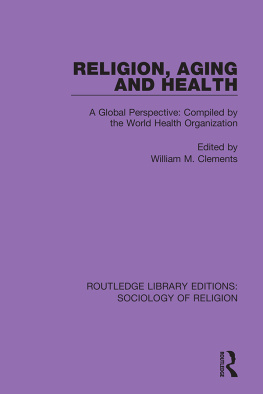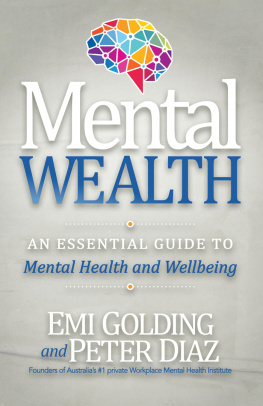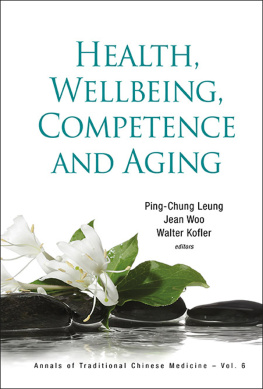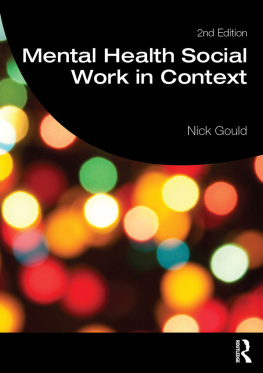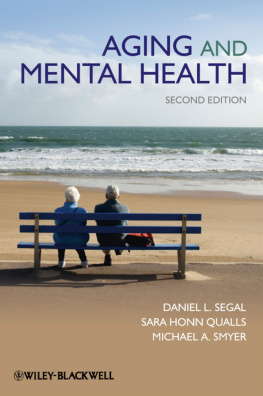ROUTLEDGE LIBRARY EDITIONS: SOCIOLOGY OF RELIGION
Volume 8
RELIGION, AGING AND HEALTH
RELIGION, AGING AND HEALTH
A Global Perspective: Compiled by the World Health Organization
Edited by
WILLIAM M. CLEMENTS
First published in 1989 by The Haworth Press, Inc.
This edition first published in 2019
by Routledge
2 Park Square, Milton Park, Abingdon, Oxon OX14 4RN
and by Routledge
52 Vanderbilt Avenue, New York, NY 10017
Routledge is an imprint of the Taylor & Francis Group, an informa business
1989 The Haworth Press, Inc.
All rights reserved. No part of this book may be reprinted or reproduced or utilised in any form or by any electronic, mechanical, or other means, now known or hereafter invented, including photocopying and recording, or in any information storage or retrieval system, without permission in writing from the publishers.
Trademark notice: Product or corporate names may be trademarks or registered trademarks, and are used only for identification and explanation without intent to infringe.
British Library Cataloguing in Publication Data
A catalogue record for this book is available from the British Library
ISBN: 978-0-367-02386-7 (Set)
ISBN: 978-0-429-02545-7 (Set) (ebk)
ISBN: 978-0-367-03119-0 (Volume 8) (hbk)
ISBN: 978-0-367-07408-1 (Volume 8) (pbk)
ISBN: 978-0-429-02056-8 (Volume 8) (ebk)
Publishers Note
The publisher has gone to great lengths to ensure the quality of this reprint but points out that some imperfections in the original copies may be apparent.
Disclaimer
The publisher has made every effort to trace copyright holders and would welcome correspondence from those they have been unable to trace.
Religion, Aging and Health: A Global Perspective
Compiled by the World Health Organization
William M. Clements
Editor
Religion, Aging and Health: A Global Perspective has also been published as Journal of Religion & Aging, Volume 4, Numbers 3/4 1988.
Copyright 1989 by The Haworth Press, Inc. All rights reserved. No part of this work may be reproduced or utilized in any form or by any means, electronic or mechanical, including photocopying, microfilm and recording, or by any information storage and retrieval system, without permission in writing from the publisher. Printed in the United States of America.
The Haworth Press, Inc. 10 Alice Street, Binghamton, NY 13904-1580
EUROSPAN/Haworth, 3 Henrietta Street, London WC2E 8LU England
LIBRARY OF CONGRESS
Library of Congress Cataloglng-ln-Publlcatlon Data
Religion, aging, and health: a global perspective / William M. Clements, editor.
p. cm.
Also published as Journal of religion & aging, volume 4, numbers 3/4 1988 T.p. verso.
Includes bibliographical references.
ISBN 0-86656-803-4
1. Aging Religious aspects. 2. Aged Health and hygiene. I. Clements, William M., 1945-
BL65.A46R44 1988
291.1783426 de 19
88-16357
CIP
Religion, Aging and Health: A Global Perspective
CONTENTS
William M. Clements
Paul Tournier
Hakim Mohammed Said
Daw Khin Myo Chit
Rebecca G. Adams
Bonnie J. Stark
A. Michael Davies
Takehiko Okada
Carmen Barros
Fumimaso Fukui
Takeshi Mitsuhashi
Jeffrey S. Levin
ABOUT THE EDITOR
William M. Clements, PhD, is Director of Behavioral Science, Family Practice Residency Program, at The Medical Center in Columbus, Georgia, He is also Associate Professor and Pastoral Counselor at the Emory University School of Medicine in Atlanta, Georgia. Dr. Clements, whose specialties are in religion, gerontology, and medicine, has published articles in leading religious and medical journals. He is a diplomate of the American Association of Pastoral Counselors and a minister in the United Methodist Church. Dr. Clements is the editor of the Journal of Religion & Aging.
Stimulated by the movement to attain health for all people by the year 2000, the World Health Organization launched a worldwide programme in the 1980s to promote and protect the health of elderly persons.
All countries of the developed world have health and social programmes for their senior citizens. These are long established and have often evolved from altruistic actions inspired by the predominating moral and religious beliefs of the society.
Services and programmes for elders in developing countries are likely to arise by a similar process, depending on the particular cultural, religious or social pattern.
In both developed and developing countries, national programmes for elderly people are directed towards maintaining wellbeing in the three dimensions defined in the WHO Constitution, namely physical, mental and social. In 1984, the Organizations Member States discussed extending this broad definition even further, to include a spiritual dimension.
By the year 2000, some six hundred million elderly people will inhabit the earth, the great majority within developing societies that have dominant religious cultures Hinduism, Buddhism, Islam, Christianity and others. Any erosion of the lifestyles and the traditional behaviour associated with these religions will have consequences for the wellbeing of the older members of the society.
The purpose of this publication is therefore to identify those elements of tradition, behaviour and lifestyle that are health protective in that, by adhering to them, physical, mental and social wellbeing will be maintained as people grow old, and culturally relevant health policies will be developed.
The World Health Organization identified contributors to this volume, with the assistance of the staff of its six regional offices. The Organization is grateful to the contributors who are identified with the relevant chapter heading. The solicited contributions were then edited by Dr. William Clements, Editor of the Journal of Religion & Aging, to whom the Organization is indebted for bringing the volume to publication.
The publication offers a global perspective to religion, aging and health which is of relevance to all generations, not only to elderly people.
David M. Macfadyen
Chief Health of the Elderly
World Health Organization
Permission to publish this material has been granted by the World Health Organization.
William M. Clements
Many factors influence human aging and longevity. Among these are phenomena such as culture, disease, nutrition, shelter, hygiene, genetics, religion, and education. The influence that each factor has on lifestyle, behavior and aging can be extraordinarily complex. These influential factors do not operate in isolation from all other matters that shape lifestyle, behavior and aging. At any one time in any single human life there is an enormously complex interrelationship between hundreds of variables. The task of describing these variables and isolating them from the context in which they naturally appear is a highly abstract activity. In order to accomplish the task of description scholars must choose some significant variables and ignore hundreds of others that undoubtedly have important influences on human behavior, lifestyle, and aging. (See Figure 1.)

